The constellations best seen in February are Auriga, Camelopardalis, Canis Major, Columba, Gemini, Monoceros and Puppis. Auriga, Camelopardalis, Gemini and Monoceros are northern constellations, while Canis Major, Columba and Puppis are located in the southern celestial hemisphere.
February is the best time of year to observe a number of interesting deep sky objects found in these constellations. Some of the best known ones are the open star clusters Messier 36, Messier 37 and Messier 38, the Eskimo Nebula, the Christmas Tree Cluster, the Cone Nebula and the Rosette Nebula.
Camelopardalis is the largest and northernmost of the February constellations. Occupying an area 757 square degrees in size, it is the 18th largest constellation in the sky. It represents the giraffe. Even though it takes up a large area of the northern sky between Ursa Major and Cassiopeia, Camelopardalis is not particularly prominent because it does not have any stars brighter than magnitude 3.00.
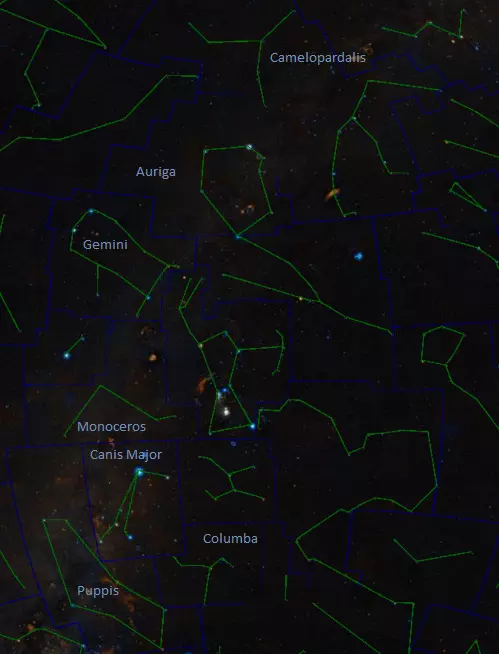
February constellations, image: Wikisky
The constellation contains Kemble’s Cascade – an asterism formed by more than 20 stars arranged in a chain that points towards Cassiopeia and ends with a small open cluster, NGC 1502. Other deep sky objects in Camelopardalis include NGC 2403, an intermediate spiral galaxy that belongs to the M81 Group, the dwarf irregular galaxy NGC 1569, and the planetary nebula NGC 1501, also known as the Oyster Nebula.
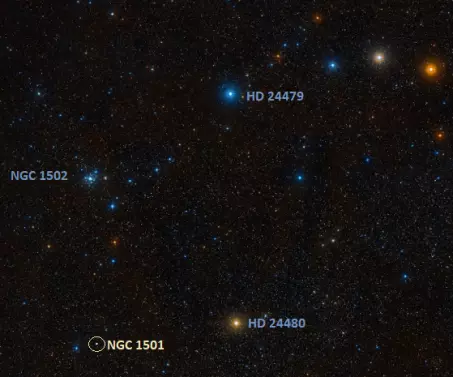
Oyster Nebula, Kemble’s Cascade and NGC 1502, image: Wikisky
Auriga, or the Charioteer, is considerably more noticeable in the winter sky. Named for its shape, resembling that of a charioteer’s helmet, Auriga is one of the most recognizable winter constellations. With an area 657 square degrees in size, it is one of the larger star constellations. It contains several stars brighter than fourth magnitude, including Capella, the sixth brightest star in the sky. Capella marks one of the vertices of the Winter Hexagon, an asterism that dominates the winter sky, which it forms with Rigel in Orion, Aldebaran in Taurus, Castor and Pollux in Gemini, Procyon in Canis Minor and Sirius in Canis Major constellation.
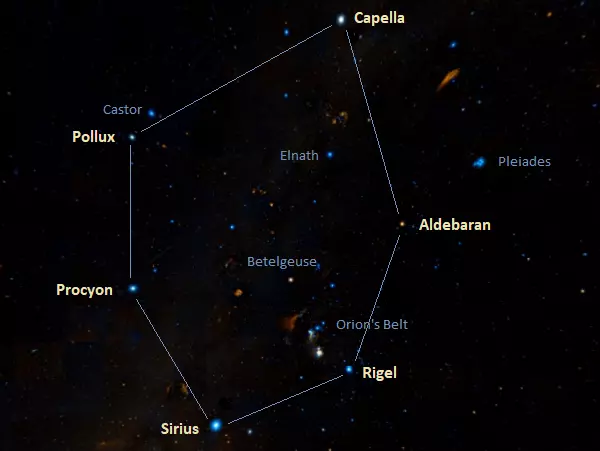
Winter Hexagon, image: Wikisky
Auriga is also home to several Messier clusters, the open clusters Messier 36, Messier 37 and Messier 38, as well as to the Flaming Star Nebula, an emission and reflection nebula surrounding the irregular variable star AE Aurigae.
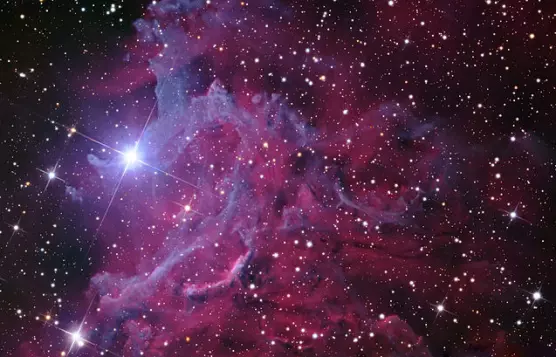
AE Aurigae and the Flaming Star Nebula (IC 405), image: Adam Block/Mount Lemmon SkyCenter/University of Arizona (CC BY-SA 4.0)
The zodiac constellation Gemini is slightly smaller and not as prominent, but its brightest stars, Pollux and Castor, which mark the heads of the celestial twins, make it easy to spot on a clear night. Pollux, the brightest star in the constellation, is the closest giant star to our solar system. With a visual magnitude of 1.14, the evolved orange giant is the 17th brightest star in the sky, while its twin Castor, a multiple star system, is the 24th, with a combined apparent magnitude of 1.58.
Gemini is home to several notable deep sky objects. These include the large open cluster Messier 35, the planetary nebulae NGC 2392 (also known as the Eskimo Nebula or Clown Face Nebula) and the Medusa Nebula, and the galactic supernova remnant IC 443, also known as the Jellyfish Nebula.
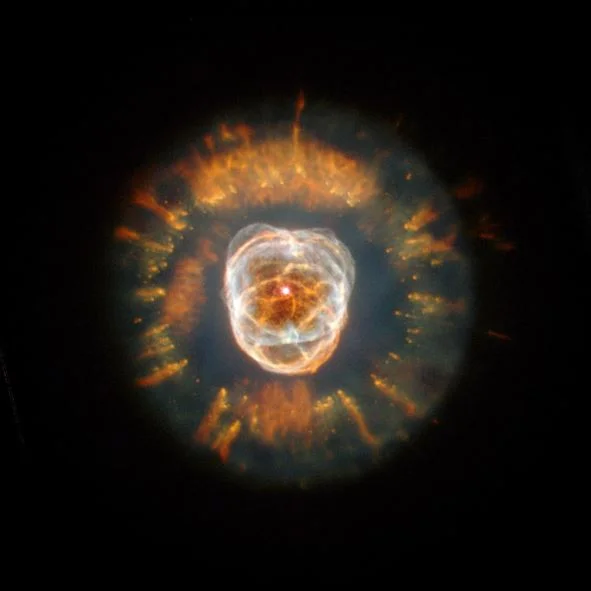
Eskimo nebula (NGC 2392). In its first glimpse of the heavens following the successful December 1999 servicing mission, NASA’s Hubble Space Telescope captured a majestic view of a planetary nebula, the glowing remains of a Sun-like star. This stellar relic, first spied by William Herschel in 1787, is nicknamed the “Eskimo” Nebula (NGC 2392) because, when viewed through ground-based telescopes, it resembles a face surrounded by a fur parka. In this Hubble telescope image, the “parka” is really a disk of material embellished with a ring of comet-shaped objects, with their tails winding away from the central star. The Eskimo’s “face” also contains some fascinating details. Although this bright central region resembles a ball of twine, it is, in reality, a bubble of material being blown into space by the central star’s intense “wind” of high-speed material. Image: NASA, ESA, Andrew Fruchter (STScI), and the ERO team (STScI + ST-ECF)
Monoceros, the Unicorn, is relatively faint, with no stars brighter than magnitude 3.00, but it contains several well-known variable stars – V838 Monocerotis, S Monocerotis and R Monocerotis – as well as Plaskett’s Star (V640 Monocerotis), one of the most massive binary stars known. The constellation is also home to A0620-00, a binary system that contains the nearest known black hole to the Sun, located at an approximate distance of 3,300 light years.
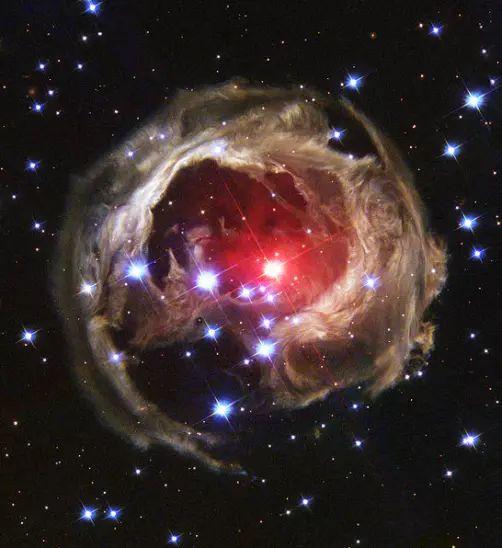
In January 2002, a dull star in an obscure constellation suddenly became 600,000 times more luminous than our Sun, temporarily making it the brightest star in our Milky Way galaxy. The mysterious star, called V838 Monocerotis, has long since faded back to obscurity. But observations by NASA’s Hubble Space Telescope of a phenomenon called a “light echo” around the star have uncovered remarkable new features. These details promise to provide astronomers with a CAT-scan-like probe of the three-dimensional structure of shells of dust surrounding an aging star. Image: NASA and The Hubble Heritage Team (AURA/STScI)
Monoceros has long been a favourite among stargazers, as it contains a number of well-known nebulae and clusters. These include the open cluster Messier 50, the Christmas Tree Cluster with the Cone Nebula (NGC 2264), the Rosette Nebula (NGC 2237, 2238, 2239 and 2264) and Hubble’s Variable Nebula (NGC 2261), illuminated by the young variable star R Monocerotis.
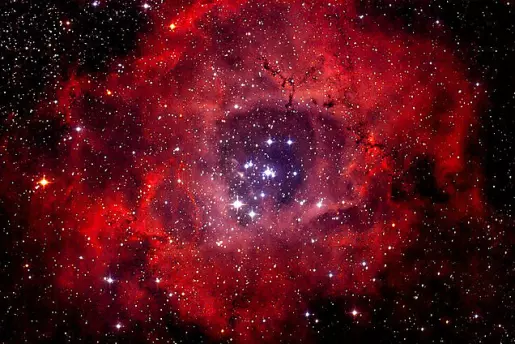
NGC 2244 and the Rosette Nebula, image: Andreas Fink (CC BY-SA 3.0)
Canis Major is slightly smaller but considerably brighter than Monoceros. Home to Sirius, the brightest star in the sky and one of the nearest stars to the solar system, the constellation is easy to find in the winter sky as it sits next to Orion. The three stars of Orion’s Belt point directly at Sirius.
Sirius has an apparent magnitude of -1.46, which makes it almost twice as bright as the second brightest star, Canopus. It is a binary star system consisting of an A-type main sequence star and a faint white dwarf. The system is only 8.60 light years distant from Earth. It is part of two major asterisms, the Winter Hexagon and the Winter Triangle, which dominate the evening sky in the winter months.
Canis Major contains four other stars brighter than magnitude 3.00 – Adhara (Epsilon CMa), Wezen (Delta CMa), Mirzam (Beta CMa) and Aludra (Eta CMa) – but these are a lot more distant than Sirius and considerably more luminous.
Notable deep sky objects in Canis Major include the open clusters Messier 41, Caroline’s Cluster (NGC 2360) and the Tau Canis Majoris Cluster (NGC 2362), the emission nebula NGC 2359, also known as Thor’s Helmet, the interacting spiral galaxies NGC 2207 and IC 2163, and the Canis Major Dwarf Galaxy, the closest neighbouring satellite galaxy to Earth.
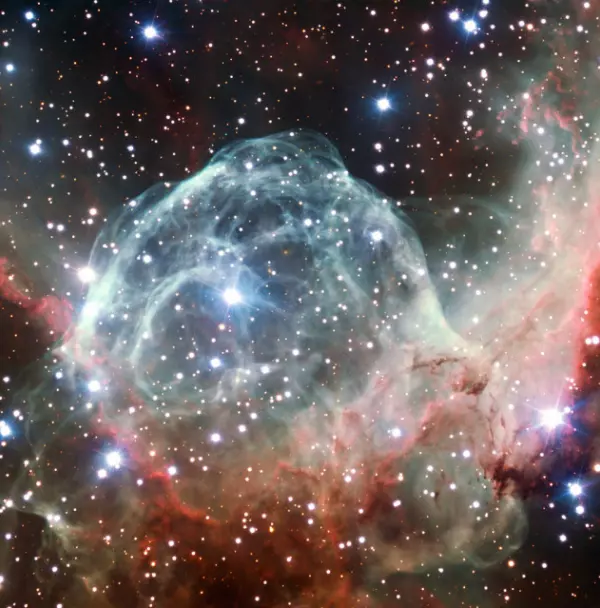
This object, also known as NGC 2359, lies in the constellation of Canis Major (The Great Dog). The helmet-shaped nebula is around 15 000 light-years away from Earth and is over 30 light-years across. The helmet is a cosmic bubble, blown as the wind from the bright, massive star near the bubble’s centre sweeps through the surrounding molecular cloud. Image: ESO/B. Bailleul
Puppis is one of the larger constellations, occupying an area of 673 square degrees in the southern sky. It was once part of the much larger constellation known as the Argo Navis together with the constellations Carina and Vela. Argo Navis represented the ship on which Jason and the Argonauts sailed to Colchis to find the Golden Fleece, and Puppis represented the ship’s stern.
Puppis contains several bright open clusters – Messier 46, Messier 47, Messier 93, NGC 2451 and NGC 2477 – as well as the planetary nebulae NGC 2438, superimposed on M46, and NGC 2440. The constellation is also home to the stunning star-forming region NGC 2467, better known by the name Skull and Crossbones Nebula.
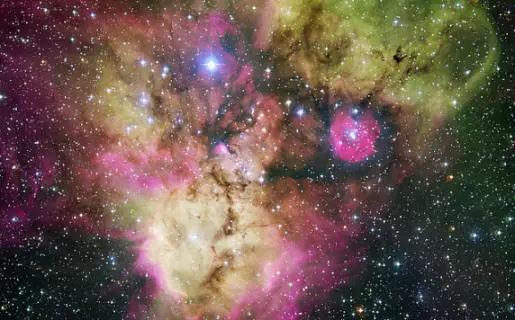
Area surrounding the stellar cluster NGC 2467, located in the southern constellation of Puppis (“The Stern”). With an age of a few million years at most, it is a very active stellar nursery, where new stars are born continuously from large clouds of dust and gas. Image: ESO
Columba, representing the dove, is a small, faint constellation that, like Puppis, cannot be seen north of the mid-northern latitudes. Located south of Canis Major and Lepus, the constellation does not have any particularly bright stars, but is home to several interesting deep sky objects, among them the globular cluster NGC 1851, the Seyfert galaxy NGC 1808 and the spiral galaxy NGC 1792.
The table below shows the latitudes between which the February constellations are visible.
| Constellation | Northern latitude | Southern latitude |
| Auriga | 90° | 40° |
| Camelopardalis | 90° | 10° |
| Canis Major | 60° | 90° |
| Columba | 45° | 90° |
| Gemini | 90° | 60° |
| Monoceros | 75° | 90° |
| Puppis | 40° | 90° |